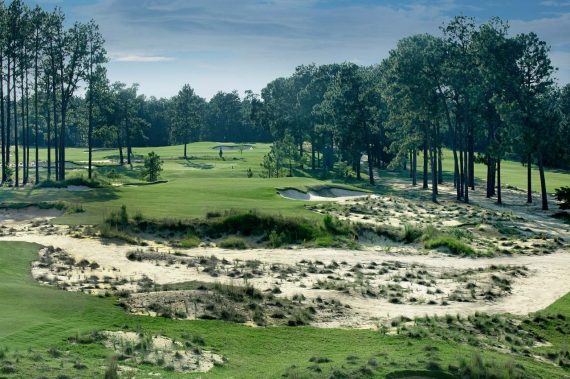Last week, Gil Hanse was in town to once more walk his new design of Pinehurst No. 4. We tagged along, and noted a few of his thoughts. With the course opening in just two weeks, it was great to hear what he had to say about different holes, locations and even his philosophy not just on how he went about the new design of No. 4, but why he designed certain features the way he did.

The 11th hole of Pinehurst No. 4, a new design by Gil Hanse.
To wit:
- Standing on the 6th green, Gil started to turn and look all around him. It’s the highest point in elevation on No. 4, and with the full 360-degree vista around him, Gil made a quick count. “Fifteen,” he said. “We can see 15 holes of No. 4 from this one spot.”
- Those vistas were an integral part of Gil’s design. “I don’t know if there’s anywhere else in the Carolinas Sandhills where you have the opportunity to get this sort of sweeping grand scale for a property. That was one of the first things that caught our eye when we walked out onto the site. And we’re hopeful that our design has captured the full potential of that.”
- Getting onto that green at the 6th is going to be a triumph for the golfer. Not just for his or her score…but for the view. “It’s a very big golf hole. So once you’re on the green a sense of relief, obviously, ensues, but taking a look around the property from this high perch is perhaps one of the finest views all around—certainly at Pinehurst — but all around the Carolina Sandhills.”
- Gil not only thinks about how a golfer will play a hole, but how he or she might look at it, even from the moment they put a tee into the ground. That’s what led Gil and his team to build expansive features in front of many of No. 4’s teeing areas: “When you stand on the tee—and that’s the only place on a golf course that the golf course architect can place you; obviously once you’ve hit a tee shot, you could be anywhere —we need to paint the picture we want you to see, and the foregrounds on a lot of golf holes, like on 15, 5, 11 and 12, can provide very dramatic vistas.”
- When you walk with Gil, the architectural notes are going to become more readily apparent. For most of us, the course is a beautiful setting and a great view with great holes. But careful golf architecture is involved to a very high degree here. Gil noted that. “We focused an awful lot on the landscape itself, restoring the character of the ground, putting the ridges back where they were before, restoring the valleys in their place. We’re hopeful that our contributions to it from a thought process, from angles, from strategy, from a thinking person’s golf course, will really stimulate people to want to play it, and take time to learn it. Because I think any golf course that is of a high quality is worthy of thoughtful design, thoughtful study, thought in how you approach it. And hopefully every single time you play you see something a little bit different, or you say, ‘OK, next time I’m going to play it this way.’ And I think that our hope is certainly that we’ve created that in Course No. 4. It’s going to be a long-term experience, one that you’re going to want to encounter over and over again, and that it’s going to again, sit very nicely next to the great, great golf course that is course No. 2.”

